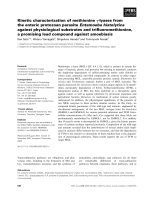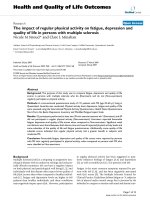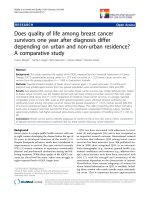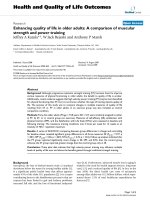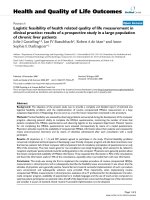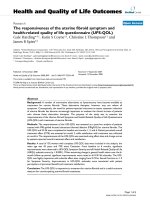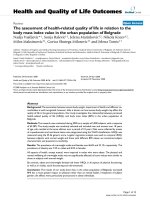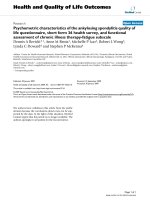báo cáo hóa học: " Does quality of life among breast cancer survivors one year after diagnosis differ depending on urban and non-urban residence? A comparative study" potx
Bạn đang xem bản rút gọn của tài liệu. Xem và tải ngay bản đầy đủ của tài liệu tại đây (347.47 KB, 10 trang )
RESEARC H Open Access
Does quality of life among breast cancer
survivors one year after diagnosis differ
depending on urban and non-urban residence?
A comparative study
Tracey DiSipio
1*
, Sandi C Hayes
1
, Beth Newman
1
, Joanne Aitken
2
, Monika Janda
1
Abstract
Background: This study examined the quality of life (QOL), measured by the Functional Assessment of Cancer
Therapy (FACT) questionnaire, among urban (n = 277) and non-urban (n = 323) breast cancer survivors and
women from the general population (n = 1140) in Queensland, Australia.
Methods: Population-based samples of breast cancer survivors aged < 75 years who were 12 months post-
diagnosis and similarly-aged women from the general population were recruited between 2002 and 2007.
Results: Age-adjusted QOL among urban and non-urban breast cancer survivors was similar, although QOL related
to breast cancer concerns was the weakest domain and was lower among non-urban survivors than their urban
counterparts (36.8 versus 40.4, P < 0.01). Irrespective of residence, breast cancer survivors, on average, reported
comparable scores on most QOL scales as their general population peers, although physical well-being was
significantly lower among non-urban sur vivors (versus the general population, P < 0.01). Overall, around 20%-33%
of survivors experienced lower QOL than peers without the disease. The odds of reporting QOL below normative
levels were increased more than two-fold for those who experienced complications following surgery, reported
upper-body problems, had higher perceived stress levels and/or a poor perception of handling stress (P < 0.01 for
all).
Conclusions: Results can be used to identify subgroups of women at risk of low QOL and to inform components
of tailored recovery interventions to optimize QOL for these women following cancer treatment.
Background
Breast cancer is a major public health concern, with one
in eight women developing the disease before the age of
85 years in developed countries of the world [1,2].
Despite therapeutic advances, which have contributed to
improvements in survival (five-year survival currently
87%) [3] w omen continue to experience considerable
physical and psychosocial dysfunction during and fol-
lowing treatment. While these quality of life (QOL) con-
cerns are short-lived for some, others may struggle to
regain expected levels of QOL longer term.
QOL has been associated with adherence to treat-
ment [4] and prognosis [5,6] and is now recognized as
an important research outcome. International research
on factors t hat influence QOL among breast cancer
survivors has been extensive (over 300 published stu-
dies in 2008 alone integrated QOL as an outcome).
Socio-demographic (e.g., income), general health (e.g.,
medical conditions) and treatment (e.g., adjuvant ther-
apy) cha racteristics each have been associated with
QOL [7], with the strength and consistency of the
associations dependent on the characteristic of interest.
Nevertheless, there remain subgroups of women for
whom limited information on QOL is available, includ-
ing those women who reside outside major metropoli-
tan areas. This is important because approximately
* Correspondence:
1
School of Public Health, Institute of Health and Biomedical Innovation,
Queensland University of Technology, Victoria Park Road, Kelvin Grove,
Queensland, 4059, Australia
DiSipio et al . Health and Quality of Life Outcomes 2010, 8:3
/>© 2010 DiSipio et al; licensee BioMed Central Ltd. This is an Open Access article distributed under the terms of the Creati ve Co mmons
Attribution License ( which permits unrestricted use, distribution, and reproductio n in
any medium, provided the original work is properly cited.
one-third of new breast cancer cases live outside major
metropolitan areas [2].
In Australia, geographic residence influences stage at
diagnosis and type of surgery, with those living in rural
areas more likely to have a mastectomy than their urban
counterparts (38% versus 25%, respectively) [8-10]. Geo-
graphic residence also influences access to health ser-
vices [ 11], as fewer than half of regional/rural hospitals
administer chemotherapy [12], and fewer still provide
radiotherapy services [13]. Further, rural Australian
women often have to travel in excess of 100 kilometers
(i.e., 62 miles) to receive adjuvant treatment and are
away from home for approximately 20 to 43 days for
chemotherapy and radiotherapy treatment, respectively
[14,15]. Hence, it seems plausible that rural women with
breast cance r may have unique and additional burdens,
such as disruption to family life, work and financial
security [14,16], which ultimately may influence QOL
differently to that observed for women residing in urban
areas.
Research that compares QOL between urban and non-
urban cancer survivors is lacking, and from those stu-
dies that exist, results are inconsistent. Two studies sug-
gest that rural breast cancer survivors fare worse
[17,18], while one indicates that QOL is superior among
a rural group of mixed cancer survivors [19], when com-
pared with their urban counterparts. Further, there is a
paucity of information comparing the QOL among can-
cer groups with that of the general population, making
interpreta tion of findings challenging. Therefore, this
paper examines whether QOL differs between urban
and non-urban women 12 mo nths following breast can-
cer diagnosis and compares their QOL with women
from the general population residing in their respective
geographic areas. We also sought to identify characteris-
tics of breast cancer survivors associated with reporting
QOL below normative levels.
Methods
Breast cancer study samples
The Pulling Through Study (PTS) was a longitudinal,
population-based study among breast cancer survivors
living within 100 kilometers (i.e., 62 miles) of the capital
city of Brisbane in Queensland, Austr alia, and diagnosed
in 2002 [20,21]. This study was extended to include sur-
vivors from non-urban areas of Queensland, diagnosed
between April 2006 and March 2007 [22]. The Accessi-
bility/Remoteness Index of Australia (ARIA+) classifica-
tion system was used to define place of residence as
either major city, inner regional, outer regional, remote
or very remote, and is based on road distance and popu-
lation size of the nearest town [23]. The selected local-
ities within the perimeter of Brisbane fall within the
ARIA+ classification for major cities and hereafter are
referred to as ‘ urban’ . Residents of inner regional,
remote and very remote areas were pooled as the ‘non-
urban’ group and reflect the reduced access to a range
of oncology services experienced by those who live out-
side state capital cities, irrespective of the level of remo-
teness [12].
Eligible women, diagnosed with unilateral breast can-
cer at age 74 years or younger, were randomly selected
through the Queensland Cancer Registry (target sam-
ple). All cancer diagnoses in Queensland are required to
be reported to the Registry and therefore these records
provide an accurate sampling frame for recruitment.
Since breast cancer is m ostly a di sease of women 50 yrs
or older and to ensure adequate numbers were available
for specific age group analyses, younger women were
over-sampled in the urban arm of the study, while 100%
of eligible non-urban women were recruited for all age
groups. Following appropri ate ethical approval and the
requirements of the cancer registry, doctor consent to
contact eligible women (provided for 82% of the urban
sample a nd 90% of the non-urban sample) a nd partici-
pant consent was sought. Overall, 277 urban and 323
non-urban women returned co mpleted quuestionnaires
at 12 months post-diagnosis (66% and 71% of eligible
women with doctor con sent for the urban and non-
urban arms, respectively).
General population study sample
Following ethical approval, the general Queensland
population sample was derived from the Queensland
Cancer Risk Study (QCRS), a population-based survey
conducted in 2004 among English-speaking residents of
Queensland, aged 20-75 years, ra ndomly sampled within
strata defined by gender, age and geographic region
(defined by the ARIA+ classification as as major city,
inner regional, outer regional or remote/very remote).
Further details about the study methods are described
elsewhere [24]. Briefly, of the 8,398 adults who agreed
to participate in the self-administered questionnaire,
5822 (69.3%) returned surveys, of which 2727 contained
QOL information. Analyses reported in this paper
include women for whom QOL data were available and
who had no prior history of breast cancer, with 675 l iv-
ing in urban and 465 in non-urban areas of Queensland,
as defined by the ARIA+.
Questionnaires
QOL was measured among women with breast cancer at
12 months post-diagnosis using the Functional Assess-
ment of Cancer Therapy (FACT-G) questionnaire,
which is comprised of 27 items rated on a five-point
Likert scale (ranging from 0 = ‘notatall’ to 4 = ‘very
much’ ) and includes four subscales (physical, social,
emotional, and functional well-being). Higher scores
represent better well-being. Women in the QCRS
received the general population FACT instrument
DiSipio et al . Health and Quality of Life Outcomes 2010, 8:3
/>Page 2 of 10
(FACT-GP), which is identical to the FACT-G except it
excludes six illness-related items inappropriate for the
general population [25,26]. Overall FACT-GP summary
scores and subscales were pro-rated as per the FACT
manual to obtain scores comparable to the FACT-G
[27], resulting in total scores for all study gro ups ran-
ging from 0-108 for overall QOL, 0-28 for the physical,
social, and functional well-bei ng sub scales, and 0-24 for
the emotional well-being subscale. Women with breast
cancer also completed 13 questions on breast cancer
concerns and arm morbidity (FACT-B+4), with total
scores from 0-52 for the breast cancer concerns sub-
scale, and 0-160 for overall FACT-B+4. The FACT
instrument has excellent reliability and validity [28].
Demographic (age, marital sta tus, educational level,
private health insurance, occupation [29,30] and
income), general health (smoking status, body mass
index, co-morbidities, c omplications following surgery,
upper-body function [31], physical activity and stress
levels including perceived handling of stress) and treat-
ment (chemotherapy, radiotherapy, horm one therapy)
characteristics for the breast cancer study participants
were also obtained via the questionnaire, whereas infor-
mation on tumor characteristics were abstracted from
histopathology reports (e.g., type of surgery, maximum
tumor size and grade, and lymph node status).
Statistical analysis
Distributions of t he FACT scor es were approximately
normal and hence were summarized as means with 95%
confidence intervals (CIs) using SPSS (SPSS Inc, Chi-
cago, IL, version 14). Analysis of variance tests com-
pared age-adjusted mean QOL score s at 12 months
post-diagnosis between urban and non-urban breast
cancer survivors. Comparisons between breast cancer
survivors and women from the general population
involved general linear regression models to obtain
QOL scores adjusted for characteristics that differed
between the groups (i.e., potential confounding factors).
Descriptive results presented in this study have been
adjusted for the sampling fraction used to identify
younger breast cancer patients from urban areas
(weighting applied: < 50 years:1.0; ≥50 years:1.3). The
general populat ion comparison group was also weighted
by age, based on Australian Bureau of Statistics data, so
that results r eflect the a ctual female Queensland resi-
dent population (weighting applied for urban, regional,
outer regional, remote and very remote: < 50 years:1.3,
1.3, 1.4, 1.5 and 0.9, respectively; ≥50 years:0.8, 0.8, 0.7,
0.6 and 1.1, respectively) [33]. The conventional P <
0.05 level (two-tailed) was accepted as statistically signif-
icant. Differences of eight or more points in mean
FACT-B+4 scores, five or more points in mean FACT-G
scores, three or more points on the breast cancer con-
cerns subscale and two or more points for all other
subscales between urban and non-urban breast cancer
survivors or between women with breast cancer and
their general population peers were considered clinicall y
important, as recommended by developers o f the FACT
[25]. For correlates, a difference in odds ratios (ORs) of
≥1.8 or ≤0.6 was considered to be of potential clinical
relevance.
As suggested by Fayers [34], a new outcome measure
was calculated to characterize breast cancer survivors
whose QOL was below normative levels. QOL values
were calculated for each five-year age stratum of the
general population study group and subtracted from the
QOL score within the same age group of women with
breast can cer (i. e., case FACT-G minus general popula-
tion comparison group FACT-G) separately by urban
and non-urban residence [34]. Positive scores indicate
higher QOL, and negative scores indicate lower QOL,
among cases rela tive to age- (within five years) and resi-
dence-matched peers. Relative overall QOL (FACT-G)
was then categorized into groups using score differen-
tials considered clinically important to investigate the
proportions of breast cancer survivors with relative
overall QOL lower than (-5.0 points or more), similar to
(>-5.0 to < +5.0) or better than (+5.0 points or more)
the general population study group. Relative QOL was
also calculated for each subscale , using two points as
the critical threshold. A dichotomous outcome variable
was defined, combining the ‘similar’ an d ‘better’ groups,
and binar y logi stic regression was used to generate ORs
and 95% CIs to identify demographic, general health,
and clinical characteristics associated w ith QOL status
below the norm compared to the ‘ similar/better’ group.
A range o f potentially important correlates were
explored, however, only those that were found to be sta-
tis tically significan t or clinically important are reported.
Formal tests of interactions between residenc e and each
of the ch aracteristics of interest did not yield any statis-
tically significant re sults, therefor e pooled results,
adjusted for residence, are presented.
Results
Sample characteristics
Demographic and disease characteristics were similar for
the women with breast cancer in this study and those in
the target sample. The majority of women (75-80%)
were diagnosed with infiltrating ductal carcinoma,
approximately 60% received complete local excision of
their tumour and more than 50% had 10 or more lymph
nodes removed. However, participants among urban
breast cancer survivors had somewhat smaller tumor
size ( median tumour size was 14 mm) when compared
with the target sample [20-22] . For the majority of
demographic and general health characteristics, women
with breast cancer had similar cha racteristics,
DiSipio et al . Health and Quality of Life Outcomes 2010, 8:3
/>Page 3 of 10
Table 1 Participant Characteristics
Characteristics Urban general
population
a
(n = 675)
Urban breast cancer
survivors
b
(n = 277)
Non-urban general
population
a
(n = 465)
Non-urban breast cancer
survivors (n = 323)
n%n% n% n%
Demographic characteristics
Age (years) *
<50 298 57.0 99 30.0 185 55.6 107 33.1
50+ 377 43.0 178 70.0 280 44.4 216 66.9
Marital status * †
Married, or living as married 520 77.6 186 66.6 361 80.1 248 76.8
Not married 155 22.4 91 33.4 104 19.9 75 23.2
Education level * *
Grade 10 or below 219 30.2 125 46.5 186 37.0 173 53.6
Grade 12/Trade/TAFE 278 42.5 95 33.7 183 40.7 102 31.6
University or college degree 178 27.3 57 19.9 96 22.3 48 14.9
Private health insurance status * †
Yes 398 58.0 200 72.4 222 48.5 140 43.3
No 277 42.0 77 27.6 243 51.5 183 56.7
General health characteristics
Smoking status
Never smoked 364 53.6 163 59.3 250 52.9 184 57.0
Past smoker 216 31.2 84 30.0 149 31.7 102 31.6
Current smoker 95 15.2 30 10.7 66 15.3 37 11.5
Physical activity
c
*
Sedentary 94 17.5 34 12.6 81 13.7 68 21.1
Insufficient activity 194 27.9 67 23.9 125 29.4 55 17.0
Sufficient activity 387 54.6 176 63.5 259 57.0 200 61.9
Body mass index (kg/m
2
)*†
Underweight/Normal (up to
24.9)
335 41.5 108 38.5 183 50.7 116 35.9
Overweight (25-29.9) 203 27.4 80 29.0 134 29.6 91 28.2
Obese (30+) 106 25.1 55 20.0 119 14.9 100 31.0
Missing 31 6.0 34 12.5 29 4.7 16 5.0
Number of co-morbidities
d
**
†
None 126 21.6 68 23.8 84 21.4 55 17.0
One 158 19.0 68 23.7 79 24.7 74 22.9
Two 133 19.7 69 25.6 95 19.2 79 24.5
Three or more 258 39.6 72 27.0 206 34.7 115 35.6
Clinical characteristics
Adjuvant treatment - - - - †
None 42 15.8 59 18.3
Chemotherapy only 34 11.3 33 10.2
Radiotherapy only 119 43.8 105 32.5
Both 82 29.1 126 39.0
Number of complications
e
- - †
None 54 19.7 133 41.2
Yes, one to four 223 80.3 190 58.8
Abbreviations:
* Statistically significant difference (P < 0.05) between the general population and breast cancer survivors by place of location.
† Statistically significant difference (P < 0.05) between urban and non-urban breast cancer survivors.
Notes:
(a) Column percentages are standardized to the 2003 Queensland population by age.
(b) Column percentages have been weighted to correct for sampling.
(c) ‘Sedentary’ is defined as no activity; ‘Insufficient’ time is defined as participating in some activity but less than 150 minutes per week, using the sum of
walking, moderate activity and vigorous activity (weighted by 2); ‘Sufficient’ time is defined as 150 minutes per week, using the sum of walking, moderate
activity and vigorous activity (weighted by 2) [45].
(d) Co-morbidities include heart conditions, high blood pressure, high cholesterol, stroke, diabetes, lung conditions, stomach or duodenal ulcer, migraine or
headaches, arthritis, cancer other than breast, depression and other prolonged or serious illness.
(e) Complications include wound infection, other infection, skin reaction, seroma.
DiSipio et al . Health and Quality of Life Outcomes 2010, 8:3
/>Page 4 of 10
irrespective of place of residence. However, the urban
compared to the non-urban breast cancer sample was
more likely to be unmarried, have private health insur-
ance and report fewer co-morbidities, a nd less likely to
be obese (Table 1). Non-urban compared to urban
women with bre ast cancer were more likely to have
multiple forms of adjuvant therapy and less likely to
report multiple complications.
A comparison of women with or without breast can-
cer showed significant differences for several demo-
graphic and general health characteristics (Table 1).
Breast cancer survivors tended to be older or have lower
educational levels when compared with the general
population, irrespective of residence. In addition, urban
breast cancer survivors were more likely to be single,
have private health insurance, and/or fewer co-morbid-
ities (other than breast cancer), while non-urban breast
cancer survivors were more likely to be sedentary and/
or have two or more co-morbidities (other than breast
cancer), when compared with their general population
counterparts. While there was a significant (P <0.05)
difference in body mass index between urban breast
cancer survivors and their general population peers, this
was attenuated when missing values were omitted from
analyses.
QOL among urban and non-urban breast cancer survivors
Although urban breast cancer survivo rs reported higher
age-adjusted QOL s ummary and subscale scores than
Table 2 QOL scores at 12 months post-diagnosis for urban and non-urban breast cancer survivors
Quality of life Urban breast cancer survivors (n
= 277)
Non-urban breast cancer
survivors (n = 323)
Differences between residence
groups
Mean
a
95% CI Mean
a
95% CI P-Value clinical
b
Physical well-being (0-28) 24.7 24.1, 25.2 22.8 22.3, 23.3 < 0.01 ✗
Social well-being (0-28) 22.7 22.0, 23.4 22.5 21.8, 23.1 0.67 ✗
Emotional well-being (0-24) 20.1 19.6, 20.5 19.2 18.7, 19.6 < 0.01 ✗
Functional well-being (0-28) 22.4 21.8, 23.1 21.7 21.1, 22.3 0.09 ✗
Breast cancer concerns (0-52) 40.4 39.5, 41.4 36.8 36.0, 37.7 < 0.01 ✓
FACT-G (0-108) 89.7 87.9, 91.5 86.3 84.7, 88.0 < 0.01 ✗
FACT-B+4 (0-160) 130.2 127.7, 132.7 122.6 120.3, 125.0 < 0.01 ✗
Abbreviations:
FACT-G: Functional Assessment of Cancer Therapy-General; FACTB+4: Functional Assessment of Cancer Therapy-Breast additional four questions.
Notes:
(a) Adjusted for age.
(b) ✗: clinically meaningful difference between groups (two+ points for physical, social, emotional and functional well-being, three+ points for breast cancer
concerns, five+ points for FACT-G, eight+ points for FACT-B+4); ✓: no clinically meaningful difference between groups.
Table 3 Adjusted mean QOL for women with breast cancer compared with the general population stratified by
residence location
Quality of life Residence General population Breast cancer survivors Difference between groups
Mean
a
95% CI Mean
a
95% CI P-Value clinical
b
Physical well-being (0-28) urban 25.0 24.8, 25.3 24.2 23.8, 24.6 < 0.01 ✗
non-urban 25.1 24.7, 25.5 22.7 22.2, 23.2 < 0.01 ✓
Social well-being (0-28) urban 19.9 19.5, 20.4 22.4 21.6, 23.2 < 0.01 ✓
non-urban 19.6 19.0, 20.2 22.4 21.7, 23.1 < 0.01 ✓
Emotional well-being (0-24) urban 21.1 20.8, 21.4 19.6 19.1, 20.0 < 0.01 ✗
non-urban 20.9 20.5, 21.2 19.2 18.8, 19.7 < 0.01 ✗
Functional well-being (0-28) urban 20.6 20.2, 21.1 22.0 21.3, 22.7 < 0.01 ✗
non-urban 20.2 19.7, 20.8 21.6 21.0, 22.3 < 0.01 ✗
FACT-G (0-108) urban 86.9 85.8, 88.0 88.0 86.3, 89.8 0.28 ✗
non-urban 85.8 84.4, 87.3 86.2 84.4, 87.9 0.79 ✗
Abbreviations:
FACT-G: Functional Assessment of Cancer Therapy-General.
Notes:
(a) Adjusted for age (years) , marital status (married or living as married, not married), education level (low, moderate, high), private health insurance status (yes,
no), smoking status (never smoked, past smoker, current smoker), physical activity (sedentary, insufficient, sufficient), body mass index (underweight/healthy,
overweight, obese, missing), and co-morbidities (none, one, two, three or more).
(b) ✗: clinically meaningful difference between groups (two+ points for physical, social, emotional and functional well-being, five+ points for FACT-G); ✓:no
clinically meaningful difference between groups.
DiSipio et al . Health and Quality of Life Outcomes 2010, 8:3
/>Page 5 of 10
their non-urban counterparts 12 months following diag-
nosis, differences did not reach the threshold for clinical
importance even for those subscales that were statisti-
cally significant (physical, emotional, and overall QOL, P
< 0.01). In contrast, well-being related to breast cancer
concerns was lower among non-urban compa red to
urban survivors by statistical (P < 0.01) and clinical cri-
teria (Table 2). Furthermore, for both groups, women
reported most detriment to their QOL for this subscale,
with participants reporting mean values below 80% of
the maximum scor e on average. Participants reported
mean values at approximately 80% of the maximum
score for all other subscales.
Breast cancer survivors’ QOL compared to the general
population
Table 3 presents the subscale and overall mean FACT-G
scores for breast cancer survivors compared with
women from the general population, stratified by resi-
dence and adjusted for potential confounding factors. At
12 months post-diagnosis, urban and non-urban breast
cancer survivors reported clinically higher social well-
being compared with their general population peers, and
non-urban breast cancer survivors also reported clini-
cally lower physical well-being (P < 0 .01 for all). Scores
for emotional, functional and overall (FACT-G) QOL
were clinically comparable to their counterparts from
the general population despite a statistically significant
difference for emotional and functional well-being (P <
0.01).
Using the new outcome measure of QOL relative to
age and residency-matched women from the general
population, depending on the specific QOL scale,
between 17.2% and 32.8% of all women with breast can-
cer reported clinically lower QOL 12 months following
diagnosis than age- (within five years) and residence-
matched women without the disease. A further 17.5%-
48.5% of women reported similar QOL, while the
remainder (19.8%-65.3%) reported clinically better QOL
(Figure 1). The subscales with the highest proportions
below the norm were emotional (32.8%) and physical
(29.3%) well-being, and overall QOL (26.2%).
Characteristics associated with QOL below normative
levels among breast cancer survivors
Following adjus tment for pot ential confounding factors,
a range of characteristics w ere associated with brea st
Figure 1 Proportions of breast cancer survivors whose relative QOL at 12 months post-diagnosis was lower than, similar to, or better
than general population peers.
DiSipio et al . Health and Quality of Life Outcomes 2010, 8:3
/>Page 6 of 10
cancer survivors reporting overall (FACT-G) QOL below
normativelevels(Table4),butplaceofresidence(i.e.,
urban versus non-urban) was not one of these (Odds
Ratio (OR) = 1.06; 95% Confidence interval (CI) = 0.64-
1.74). Experiencing one or more complications following
surgery was associated with two-fold increased odds
(OR = 2.26, 95% CI = 1.31-3.90; P < 0.01) of reporting
reduced QOL, while upper-body function below the
median, moderate or higher stress levels and poor per-
ceived handling of stress were each associated with at
least four-fold increased odds of reporting reduced QOL
(ORs ranging from 4.24-4.77, P < 0.01, see Table 4). A
marker of higher socioeconomic status, having private
health insurance, was associated with a 0.6 odds of
reporting lower relative QOL (95% CI = 0.37-0.99, P =
0.05).
Discussion
Urban and non-urban breast cancer survivors reported
similar levels of QOL 12 months following diagnosis,
overall and for subscales. The sole exception was the
breast cancer con cerns subscale, which showed that
non-urban residents fared worse than their urban coun-
terparts. When comparing breast cancer survivors to
age- and residence-matched peers, the only detriment to
QOL was among non-urban breast cancer survivors
who reported statistically and clinically poorer physical
well-being. Overall, up to one in three breast cancer sur-
vivors reported QOL below the age- and residency-
matched general female population. The major indepen-
dent correlates of reporting overall QOL below that of
age-matched women without breast cancer were compli-
cations following surgery, poorer upper-body function,
higher perceived stress levels, and poor perception of
handling stress.
Despite the known differences by geographic residence
with regards to access to services, availability of treat-
ment and survival outcomes, our results indicate only
minor disparities in QOL between urban and non-urban
breast cancer survivors 12 months post-diagnosis. The
subscale measuring breast cancer-specific concerns
yielded the lowest values (based on percent of maximum
score) reported by all survivors, but in particular for
women living in non-urban areas. Items within this sub-
scale deal with treatment-related symptoms, such as
swelling of the arms, pain, shortness of breath, body
image and sexuality. These results support existing
research which demonstrates that while QOL among
breast cancer survivors improves considerably during
the first year following completion of treatment , breast
Table 4 Correlates of QOL (FACT-G) below the norm at 12
months post-diagnosis among breast cancer survivors
a
Characteristics Model
nOR
b
95% CI P-Value
Place of residence 0.82
Urban 277 1.00 -
Non-urban 323 1.06 0.64, 1.74
Age (years) 0.21
<50 205 1.00 -
50+ 395 0.72 0.43, 1.20
Occupation 0.38
Professional 182 1.00 -
White-collar worker 176 1.16 0.64, 2.11
Blue-collar worker 31 2.53 0.95, 6.76
Homemaker 106 1.29 0.63, 2.62
Retired/student 105 0.92 0.43, 1.96
Yearly income 0.15
<$52,000 336 1.00 -
$52,000+ 207 0.60 0.35, 1.04
Missing 57 0.66 0.28, 1.55
Private health insurance
status
0.05
No 217 1.00 -
Yes 383 0.61 0.37, 0.99
Overall histological
grade
0.34
Grade 1 142 1.00 -
Grade 2 219 0.58 0.32, 1.06
Grade 3 208 0.69 0.38, 1.24
Not available 31 0.54 0.14, 2.10
Number of
complications
c
<0.01
None 187 1.00 -
Yes, one to four 413 2.26 1.31, 3.90
Upper-body function <0.01
Good function (<11) 301 1.00 -
Poor function (11+) 258 4.44 2.66, 7.40
Missing 41 3.63 1.45, 9.07
Amount of stress <0.01
Very little/some 371 1.00 -
A moderate amount/
a lot
229 4.77 2.93, 7.76
Perceived handling of
stress
<0.01
Very well/fairly well 526 1.00 -
Not well/not well at
all
74 4.24 2.21, 8.15
Notes:
(a) Mutually adjusted for all variables in the model.
(b) Odds ratio for QOL below the norm (R
2
= 0.43).
(c) Complications include wound infection, other infection, skin reaction,
seroma.
DiSipio et al . Health and Quality of Life Outcomes 2010, 8:3
/>Page 7 of 10
cancer treatment-related concerns (such as arm dysfunc-
tion, poor body image, and sexual dysfunction) may per-
sist [35-39].
It is plausible that non-urban su rvivors suffer in terms
of their breast cancer-specific QOL, more so than urban
survivors, as a consequence of inequalities in accessing
specialised se rvices. However, study-specific data collec-
tion procedures may also have contributed . QOL scores
were derived from the third questionnaire for partici-
pants in the longitudinal urban breast cancer study,
whereas the first (and only) questionnai re was the
source of QOL data for non-urban breast cancer partici-
pants. Therefore urban survivors may have responded
differently to QOL questions over time, not only
because their QOL changed, but also because they may
have become used to answering questions about Q OL
and might have over time changed their perception of
QOL. This response shift may, in part, explain what
appears to be a more positive breast cancer-specific
QOL among urban survivors than non-urban survivors.
However, the difference in QOL was observed on most
but not all subscales, suggesting that response shift
played a minor role in our findings.
On average, QOL was similar for breast cancer survi-
vors and general population peers, for both urban and
non-urban residents, similar to results reported by other
authors studying QOL among breast cancer survivors 12
months [40,41] or longer [18,26,42] following diagnosis.
The high FACT-G scores observed among breast can cer
survivors are somewhat surprising, because patients fre-
quently report ongoing symptoms and long-term side-
effects [35,36,39]. High functional and social well-being
reported by breast cancer survivors compared to their
general population counterparts contributed to their
overall high FACT-G score and contradicts previous
research [18,26,40-42]. However, the literature is domi-
nated by studies using the European Organisation for
the Research and Treatment of Cancer QOL question-
naire (EORTC QLQ-C30) [18,26,40,41]. The social well-
being subsca le of the EORTC QLQ-C30 and the FACT
have been shown to be poorly correlated (r = 0.09) [43]
suggesting they m easu re different aspects of social well-
being. Furthermore, QOL domains measured by the
FACT-G may be more relevant to short-term recovery.
Whereas 12 months or longer after diagnosis, alternate
issues may become more important for QOL, such as
fear of recurrence or making mean ing of the cancer
experience. More recently, survivorship-specific QOL
instruments have been developed, and further research
is needed to assess whether these will uncover additional
medium- to long-term survivorship issues [44].
Despite overall QOL similarities between survivors
and their general population peers, up to one-third
(depending on the subscale) of survivors continued to
experience lower QOL 12 months following diagnosis of
breast cancer. To our knowledge, despite Fayers suggest-
ing advanced analytical procedures using normative
scores in 2000 [34], this is the first study to assess corre-
lates of lower QOL among breast cancer survivors in
this manner. The results demonstrate that experiencing
one or more treatment-related complications, reporting
lower upper-body function than the median, moderate
to high stress levels and/or perceived poor handling of
stress could reduce the odds of good QOL two- to four-
fold. The cross-sectional nature of the data denotes that
these charact eristics are corre lates of QOL but not
necessarily causes. Moreover, the relative QOL index
used to identify these correlates may be focusing on
those women with breast cancer who would have been
in the lower part of the QOL range even before they
had the disease. Regardless, these correlates have rele-
vance for identifying subgroups of breast cancer survi-
vors who require assistance to regain QOL to levels
expected among age-matched peers from the general
population.
Several key design features of this work highlight the
strength and importance of the findings. Results were
obtained from pop ulation-based urban a nd non-urban
breast cancer samples, representative of their respective
target populations [20-22] , and therefore results are
likely generalizable to the wider population of breast
cancer survivors. Further, QOL of survivors were com-
pared to peers witho ut breast cancer, including match-
ing for place of r esidence, allowi ng for more accurate
interpretation of meaning of results. At a glance, the
results from this study suggest that, overall, women with
breast cancer fare well by 12 months following diagno-
sis; however, interventions are needed to improve breast
cancer-related concerns among all women with breast
cancer and physical well-being among non-urban survi-
vors. These should specifically recruit those survivors
who experience complications followin g surgery, upper-
bod y dys function and/or those with a greater burden of
stress (i.e., higher amounts and/or poor self-perceived
handl ing of stress). Interv entions that address such con-
cerns and that are accessible for all women, irrespective
of place of residence, may help facilitate a faster return
to optimal QOL in the future.
Conclusions
Overall, the QOL of breast cancer survivors living in
rural and urban areas was similar except for breast can-
cer related concerns being more dominant in women
from rural locations. Among all women about 20%-33%
have lower QOL one year past diagnosis compared to
age matched women from the general population with-
out breast cancer and thus could benefit from additional
support and interventions.
DiSipio et al . Health and Quality of Life Outcomes 2010, 8:3
/>Page 8 of 10
List of abbreviatio ns
ARIA+: Accessibility/Remoteness Index of Australia; CI:
Confidence Interval; EORTC: European Organisation for
the Research and Treatment of Cancer; FACT: Func-
tional Assessment of Cancer Therapy; FACT-G: Func-
tional Assessment of Cancer Therapy-General; FACT-
GP: F unctional Assessment of Cancer Therapy-General
Population; FACTB+4: Functional Assessment of Cancer
Therapy-Breast additional four questions; OR: Odds
Ratio; PTS: Pulling Through Study; QOL: Quality of
Life; QCRS: Queensland Cancer Risk Study.
Acknowledgements
This work was supported by the National Breast Cancer Foundation, with
research project funding for the Pulling Through Study, scholarship support
for the first author and fellowship support for the second author, and by the
Cancer Council Queensland for the Queensland Cancer Risk Study. Monika
Janda is supported by NHMRC-CDA-553034.
Author details
1
School of Public Health, Institute of Health and Biomedical Innovation,
Queensland University of Technology, Victoria Park Road, Kelvin Grove,
Queensland, 4059, Australia.
2
Viertel Centre for Research in Cancer Control,
Cancer Council Queensland, PO Box 201, Spring Hill, Queensland, 4004,
Australia.
Authors’ contributions
TD carried out data collection and analysis. SH, BN, and MJ supervised TD
and contributed to data interpretation and manuscript writing. JA supervised
data collection at the Cancer Registry and provided critical input in data
collection, analysis and manuscript. All authors read and approved the final
manuscript.
Competing interests
The authors declare that they have no competing interests.
Received: 17 August 2009
Accepted: 7 January 2010 Published: 7 January 2010
References
1. American Cancer Society: Breast Cancer Facts Figures 2007-2008. Atlanta:
American Cancer Society, Inc 2008.
2. Australian Institute of Health and Welfare (AIHW), Australasian Association
of Cancer Registries (AACR): Cancer in Australia: An overview, 2006.
Canberra: AIHW 2007.
3. Youlden D, Baade P, Coory M: Cancer Survival in Queensland, 2002.
Brisbane: Queensland Health and Queensland Cancer Fund 2005.
4. Richardson L, Wang W, Hartzema A, Wagner S: The role of health-related
quality of life in early discontinuation of chemotherapy for breast
cancer. Breast J 2007, 13(6):581-587.
5. Coates A, Gebski V, Signorini D, Murray P, McNeil D, Byrne M, Forbes J,
Australian New Zealand Breast Cancer Trials Group: Prognostic value of
quality-of-life scores during chemotherapy for advanced breast cancer. J
Clin Oncol 1992, 10(12):1833-1838.
6. Gupta D, Granick J, Grutsch J, Lis C: The prognostic association of health-
related quality of life scores with survival in breast cancer. Support Care
Cancer 2007, 15:387-393.
7. Mols F, Vingerhoets A, Coebergh J, Poll-Franse van de L: Quality of life
among long-term breast cancer survivors: A systematic review. Eur J
Cancer 2005, 41:2613-2619.
8. Hall S, Holman C, Hendrie D, Spilsbury K: Unequal access to breast-
conserving surgery in Western Australia 1982-2000. ANZ J Surg 2004,
74(6):413-419.
9. Kricker A, Haskill J, Armstrong B: Breast conservation, mastectomy and
axillary surgery in New South Wales women in 1992 and 1995. Br J
Cancer 2001, 85(5):668-673.
10. Thompson B, Baade P, Coory M, Carriere P, Fritschi L: Patterns of surgical
treatment for women diagnosed with early breast cancer in
Queensland. Ann Surg Oncol 2008, 15(2):443-451.
11. Australian Institute of Health and Welfare (AIHW): Rural, Regional and
Remote Health: Indicators of Health. Canberra: AIHW (Rural Health Series
no. 5) 2005.
12. Clinical Oncological Society of Australia: Mapping Rural and Regional
Oncology Services in Australia. COSA 2006.
13. NHMRC National Breast Cancer Centre: Clinical Practice Guidelines for the
Management of Early Breast Cancer. Canberra: NHMRC, 2 2001.
14. Hegney D, Pearce S, Rogers-Clark C, Martin-McDonald K, Buikstra E: Close,
but still too far. The experience of Australian people with cancer
commuting from a regional to a capital city for radiotherapy treatment.
Eur J Cancer Care 2005, 14(1):75-82.
15. Williams P, Rankin N, Redman S, Davis C, Armstrong B, Malycha P, Girgis A:
National Survey of Women with Early Breast Cancer: Their Perceptions
of Care (1997). Camperdown NSW: National Breast Cancer Centre 2004.
16. McGrath P, Patterson C, Yates P, Treloar S, Oldenburg B, Loos C: A study of
postdiagnosis breast cancer concerns for women living in rural and
remote Queensland. Part I: Personal concerns. Aust J Rural Health 1999,
7(1):34-42.
17. Lyons M, Shelton M: Psychosocial impact of cancer in low-income rural/
urban women: Phase II. Online Journal of Rural Nursing and Health Care
2004,
4(2).
18. Waldmann A, Pritzkuleit R, Raspe H, Katalinic A: The OVIS study: Health
related quality of life measured by the EORTC QLQ-C30 and -BR23 in
German female patients with breast cancer from Schleswig-Holstein.
Qual Life Res 2007, 16(5):767-776.
19. Schultz A, Winstead-Fry P: Predictors of quality of life in rural patients
with cancer. Cancer Nurs 2001, 24(1):12-19.
20. Hayes S, Janda M, Cornish B, Battistutta D, Newman B: Lymphedema after
breast cancer: Incidence, risk factors, and effect on upper body function.
J Clin Oncol 2008, 26(21):3536-3542.
21. Round T, Hayes S, Newman B: How do recovery advice and behavioural
characteristics influence upper-body function and quality of life among
women 6 months after breast cancer diagnosis?. Support Care Cancer
2006, 14(1):22-29.
22. DiSipio T, Hayes S, Newman B, Janda M: What determines the health-
related quality of life among regional and rural breast cancer survivors?.
Aust N Z J Public Health 2009.
23. Commonwealth Department of Health and Aged Care: Measuring
Remoteness: Accessibility/Remoteness Index of Australia (ARIA). Revised
Edition. Occassional Papers: New Series Number 14. Canberra 2001.
24. DiSipio T, Rogers C, Newman B, Whiteman D, Eakin E, Fritschi L, Aitken J:
The Queensland Cancer Risk Study: Behavioural risk factor results. Aust N
Z J Public Health 2006, 30(4):375-382.
25. Brucker P, Yost K, Cashy J, Webster K, Cella D: General population and
cancer patient norms for the Functional Assessment of Cancer Therapy-
General (FACT-G). Eval Health Prof 2005, 28(2):192-211.
26. Holzner B, Kemmler G, Cella D, De Paoli C, Meraner V, Kopp M, Greil R,
Fleischhacker W, Sperner-Unterweger B: Normative data for functional
assessment of cancer therapy: General scale and its use for the
interpretation of quality of life scores in cancer survivors. Acta Oncol
2004, 43(2):153-160.
27. Cella D: Manual of the Functional Assessment of Chronic Illness Therapy
(FACIT). Evanston: Center on Outcomes Research and Education (CORE),
Evanston Northwestern Healthcare and Northwestern University 1997.
28. Cella D, Tulsky D, Gray G, Sarafian B, Linn E, Bonomi A, Silberman M,
Yellen S, Winicour P, Brannon J, et al: The Functional Assessment of
Cancer Therapy scale: Development and validation of the general
measure. J Clin Oncol 1993, 11(3):570-579.
29. Australian Bureau of Statistics (ABS): Australian Standard Classification of
Occupations. Canberra: ABS 1997.
30. Australian Taxation Office: Taxation Laws Amendment (Personal Income
Tax Reduction) Bill 2003 (No. 163 of 2002-03). Canberra: Australian
Government Publishing Service 2003.
31. Solway S, Beaton D, McConnell S, Bombardier C: The DASH Outcome
Measure User’s Manual. Toronto: Institute for Work and Health, 2 2002.
32. Centers for Disease Control and Prevention (CDC): Behavioral risk factor
surveillance system survey questionnaire. Atlanta, Georgia: US
DiSipio et al . Health and Quality of Life Outcomes 2010, 8:3
/>Page 9 of 10
Department of Health and Human Services, Centers for Disease Control and
Prevention 2001.
33. Australian Bureau of Statistics (ABS): 2001 Census of Population and
Housing: Australia in Profile: A Regional Analysis. Canberra: ABS 2004.
34. Fayers P, Machin D: Quality of life: Assessment, analysis and
interpretation. Chichester: Wiley & Sons 2000.
35. Engel J, Kerr J, Schlesinger-Rabb A, Sauer H, Holzel D: Axilla surgery
severely affects quality of life: Results of a 5-year prospective study in
breast cancer patients. Breast Cancer Res Treat 2003, 79(Supplement 1):47-
57.
36. Ganz P, Desmond K, Leedham B, Rowland J, Meyerowitz B, Belin T: Quality
of life in long-term, disease-free survivors of breast cancer: A follow-up
study. J Natl Cancer Inst 2002, 94(1):39-49.
37. Heim E, Valach L, Schaffner L: Coping and psychosocial adaptation:
Longitudinal effects over time and stages in breast cancer. Psychosom
Med 1997, 59(4):408-418.
38. King M, Kenny P, Shiell A, Hall J, Boyages J: Quality of life three months
and one year after first treatment for early stage breast cancer:
Influence of treatment and patient characteristics. Qual Life Res 2000,
9(7):789-800.
39. Shimozuma K, Ganz P, Petersen L, Hirji K: Quality of life in the first year
after breast cancer surgery: Rehabilitation needs and patterns of
recovery. Breast Cancer Res Treat 1999, 56(1):45-57.
40. Arndt V, Merx H, Sturmer T, Stegmaier C, Ziegler H, Brenner H: Age-specific
detriments to quality of life among breast cancer patients one year after
diagnosis. Eur J Cancer 2004, 40(5):673-680.
41. Schou I, Ekeberg O, Sandvik L, Hjermstad M, Ruland C: Multiple predictors
of health-related quality of life in early stage breast cancer. Data from a
year follow-up study compared with the general population. Qual Life
Res 2005, 14(8):1813-1823.
42. Ahn S, Park B, Noh D, Nam S, Lee E, Lee M, Kim S, Lee K, Park S, Yun Y:
Health-related quality of life in disease-free survivors of breast cancer
with the general population. Ann Oncol 2006, 18(1):173-182.
43. Holzner B, Bode R, Hahn E, Cella D, Kopp M, Sperner-Unterweger B,
Kemmler G: Equating EORTC QLQ-C30 and FACT-G scores and its use in
oncological research. Eur J Cancer 2006, 42(18):3169-3177.
44. Pearce N, Sanson-Fisher R, Campbell H: Measuring quality of life in cancer
survivors: A methodological review of existing scales. Psychooncology
2008, 17(7):629-640.
45. Department of Health and Aged Care: National physical activity
guidelines. Canberra: Commonwealth Department of Health and Aged
Care 2005.
doi:10.1186/1477-7525-8-3
Cite this article as: DiSipio et al.: Does quality of life among breast
cancer survivors one year after diagnosis differ depending on urban
and non-urban residence? A comparative study. Health and Quality of
Life Outcomes 2010 8:3.
Publish with BioMed Central and every
scientist can read your work free of charge
"BioMed Central will be the most significant development for
disseminating the results of biomedical research in our lifetime."
Sir Paul Nurse, Cancer Research UK
Your research papers will be:
available free of charge to the entire biomedical community
peer reviewed and published immediately upon acceptance
cited in PubMed and archived on PubMed Central
yours — you keep the copyright
Submit your manuscript here:
/>BioMedcentral
DiSipio et al . Health and Quality of Life Outcomes 2010, 8:3
/>Page 10 of 10
